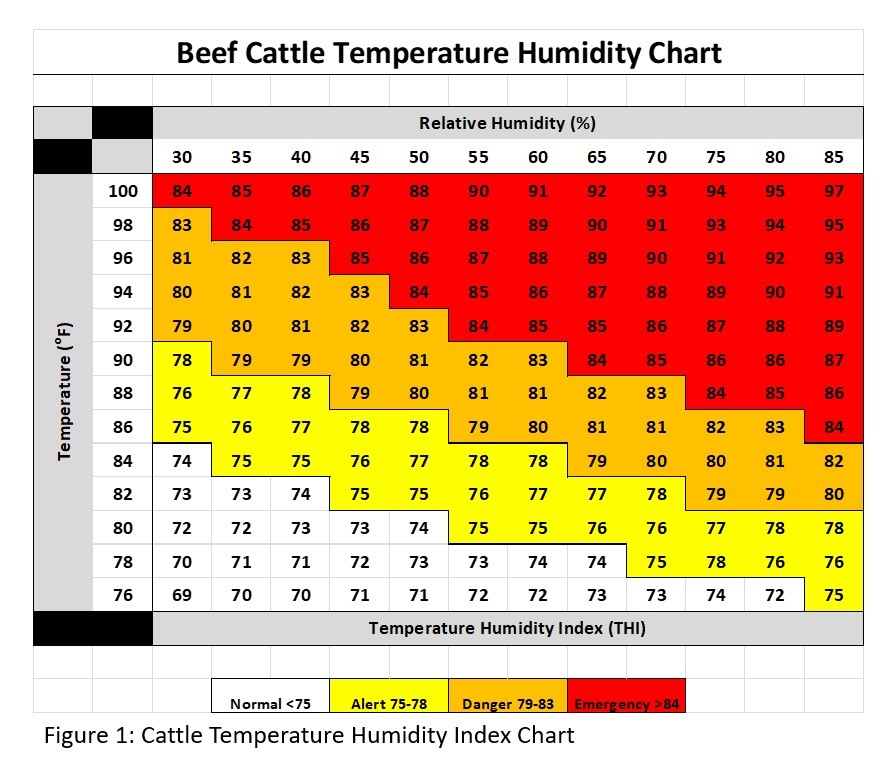
It’s that time of year again. Temperatures are rising and the air is heavy enough you can cut it with a knife. Although this weather is for growing crops, it means different things for your cattle operation. Whether in beef or dairy, producers need to understand heat stress and ways to help mitigate its effects. This in turn will keep animals productive and profitable.
Cattle are not able to dissipate heat well because of limited ability to sweat. Black hided cattle absorb more heat, and cattle naturally have an internal heat producing fermentation vat, the rumen. Since cattle cannot dissipate heat well, they have an ongoing heat load building up during the day from metabolic and radiant heat, and dissipate that heat load at night when it is cooler.
Cattle’s optimal ambient temperature is from 32 to 68 degrees Fahrenheit. At temperatures above 80 degrees, cattle endure physiologic stress that leads to decreased feed intake, decrease milk production, decreased activity, increased respiration, increased peripheral blood flow and sweating. Cattle feel the hottest two hours after the peak heat of the day, and it takes at least six hours for cattle to dissipate their heat load. For example, if the peak heat was at 3:00 pm, cattle will not have recovered until at least 11:00 pm that night.

What can producers do?
Producers can do their part by watching the forecast to help cattle through stressful heat and plan handling procedures and heat mitigating interventions accordingly. Understanding the relationship between the ambient temperature and humidity with respects to the Temperature Heat Index (THI) can help. The THI is what the temperature feels like to a body when relative humidity is combined with air temperature. Figure 1 shows a representation of how to use THI and its relationship to dangerous and emergency heat/humidity levels for cattle. Cattle are in the danger area if the temperature is 82 with 75% humidity and it is an emergency at 86 with 85% humidity. If temperatures do not get below a THI 74, they may not ever recover from their heat load before the next hot day.
Interventions
- Plan working and movement times in the morning to avoid dangerous and emergency THI levels.
- Water – provide additional sources of water. Cattle need 2-3 inches of linear water space per head during the summer. Be sure water supply is sufficient for all cattle – 1.1% of body weight per hour. A 1200-pound animal needs 1.65 gallons per hour. Add large tanks to yards.
- Provide shade – many artificial structures have been designed to provide shade to cattle. Be sure to have 20 to 40 square feet of shade per animal at least 8 feet tall to reduce crowding. Also, consider the orientation to maximize shade during the peak heat periods of the day.
- Feeding times – transition to later feedings. Heat production from feed intake and rumination peaks 4 to 6 hours after feeding. Try feeding 70% of their feed 2 to 4 hours after peak ambient heat. Also, lowering energy by 5-7% will help reduce heat load.
- Evaporative cooling and air movement– sprinklers or misters can be utilized to help with cooling animals. Larger droplets from low pressure systems are better and penetrating through the hair to the skin and are more effective but consideration must be taken for the amount of water they use and waste it creates. High pressure mister systems use less water and are just as effective when combined with fan power but if used alone, may actually increase humidity. You need air movement when using these systems.
- Bedding – providing light colored bedding during the summer will help reflect the sun and in turn buffer radiant heat from dirt and concrete. I’ve seen this reduce temperatures almost 10 degrees.
We cannot control the weather but we can do our best to help mitigate the effects of heat on livestock. Pay attention to forecasts and utilize THI to help with interventions strategies. These will help keep animals productive and minimize potential losses.
By: Dr. Aj Smit
